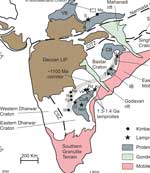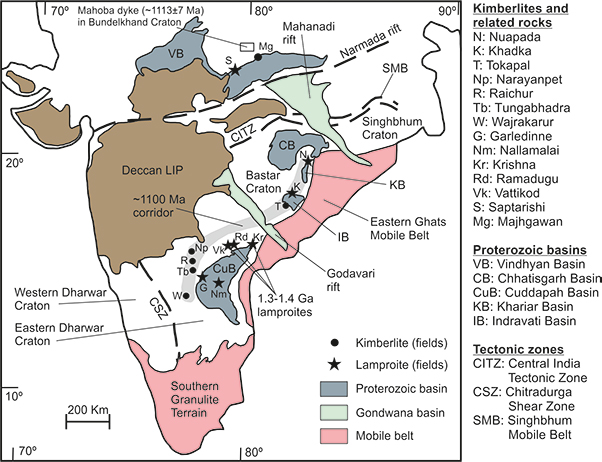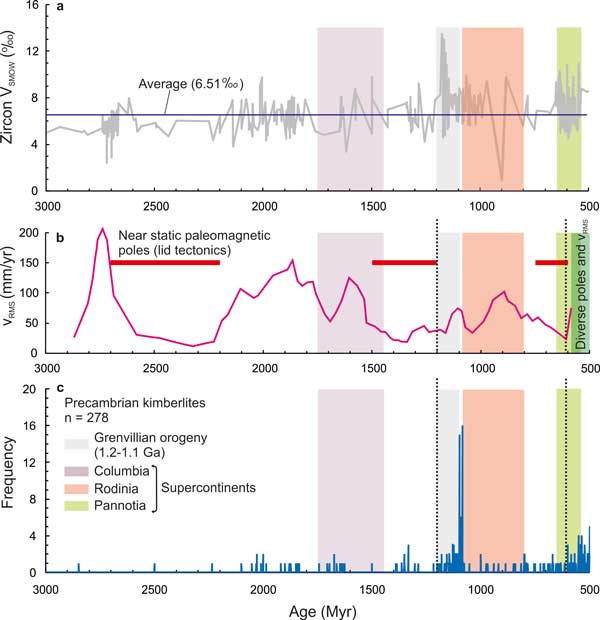 |
Supercontinent transition:
Links to ~1.1 Gyr diamondiferous kimberlites and related rocks in India |
Ashutosh Pandey & N.V. Chalapathi Rao
Mantle Petrology Laboratory, Department of Geology, Institute of Science, Banaras Hindu University, Varanasi 221005, India, ashutosh.pandey@bhu.ac.in; nvcrao@bhu.ac.in
The generation and emplacement of kimberlites and related magmas require three circumstances (Helmstaedt & Gurney, 1997):
- a volatile- and incompatible-element-enriched mantle source,
- tectonic processes that trigger partial melting of this mantle source, and
- a crustal tectonic environment that controls their emplacement.
It is now widely agreed that kimberlites are derived from an isolated and homogeneous sub-lithospheric mantle reservoir ( Woodhead et al., 2019). However, the tectonic process(es) triggering partial melting in such reservoirs remain unclear and diverse causative models have been proposed which include mantle plumes ( e.g., Crough et al., 1980; Le Roex, 1986; Torsvik et al., 2010; Chalapathi Rao & Lehmann, 2011), passive continental extension ( e.g., Moore et al., 2008; Jelsma et al., 2009), the volatile influx into the mantle as a result of subduction of oceanic plates ( Helmstaedt & Gurney, 1997), lithospheric extension caused by subducting plate flexure ( Zhang et al., 2019), and edge-driven convection ( Kjarsgaard et al., 2017).
The Eastern Dharwar Craton and the Bastar Craton of the Indian shield host numerous ~1.1 Gyr diamondiferous kimberlites and related rocks (ultramafic lamprophyres and lamproites) that are aligned parallel to a fold belt (Eastern Ghats Mobile Belt) (Kaur & Mitchell, 2016; Figure 1). Kumar et al. (2007) suggested a ‘short-lived mantle plume model’ to explain this widespread alkaline magmatism at ~1.1 Gyr on the basis of temporal correlation with the Warakurna, Keweenawan, and Umkondo Large Igneous Provinces (LIPs). We argue that ~1.1 Gyr kimberlites and related magmatism in southern India was more prolonged (1153-1023 Ma) than these contemporaneous LIPs, which were relatively short geological events (Warakurna: 1078-1070 Ma, Keweenawan: 1085-1117 Ma, Umkondo: 1112-1116 Ma). These circumstances do not support a mantle plume model.

Figure 1: Geological map of India showing ~1.1 Gyr corridor of kimberlites and related rocks which is aligned parallel to the Eastern Ghats Mobile Belt.
Magmatic provinces are linked to mantle plumes on the basis of age-wise linear magmatic geometry and excess mantle potential temperature. A classic example where linear geometry (>2000 km), along with age progression of kimberlites and related rocks, is observed is the Cretaceous North American kimberlites that are proposed to be an expression of the Great Meteor mantle plume hotspot track (see Heaman & Kjarsgaard, 2000). In contrast to this, the Mesoproterozoic Indian kimberlites and related rocks corridor lies parallel to a fold belt in the east, which is of considerable geodynamic significance. In fact, the emplacement ages of these rocks are consistent with a continental collision period responsible for the amalgamation of the Rodinia supercontinent. Various paleogeographic reconstructions of the Rodinia supercontinent place a Grenvillian (~1.1 Ga) orogenic belt at the easternmost Indian shield. A similar spatio-temporal correlation exists between ~520 Myr South African kimberlites that tap an ENE-WSW trending lineament parallel to the Damaran Orogenic Belt, which are concomitant with assembly of the Gondwana supercontinent (Jelsma et al., 2009).
Temperature estimates from the mantle xenoliths hosted in these kimberlites reveal that the ambient mantle was not anomalously hot, as expected for a mantle plume, when compared to numerical modelling and the actual sample-based mantle cooling curve through geological time (Figure 2). Mantle-plume-invoked protracted lithospheric heating has been noted from temperature estimates from the xenoliths hosted in the South African kimberlites (Franz et al., 1996; Bell et al., 2003; Boyd et al., 2004).

Figure 2: Temperature range estimated from the mantle xenoliths in the southern Indian kimberlites (Ganguly & Bhattacharya, 1987; Nehru & Reddy, 1989; Chalapathi Rao et al., 2004; Patel et al., 2009) compared to theoretical- and sample-based mantle potential temperature curves (Richter, 1988; Korenaga, 2008; Silver & Behn, 2008; Davies, 2009; Aulbach & Arndt, 2019).
The Eastern Dharwar Craton hosts abundant distinct Paleoproterozoic mafic dykes that were emplaced at 2.37-1.89 Ga. This was followed by a dearth in magmatic rocks for almost 400 Myr. The next episode of magmatism manifested in the form of 1.3-1.4 Gyr lamproites and subsequently 1.1 Gyr kimberlites, ultramafic lamprophyres, and lamproites. The gap in magmatism in the Eastern Dharwar Craton during the Mesoproterozoic (1.8-1.4 Ga) coincides with the life span of the Columbia supercontinent and the duration of continental lid (stable continent configuration) tectonics (Piper, 2013; Roberts, 2013). The intermittence of plate tectonics during this time period is manifested in the lack of passive margins, orogenic gold and volcanic-hosted massive sulphide deposits, and decelerated continental motions. Nevertheless, abundant anorogenic anorthosite magmatism occurred (see Cawood & Hawkesworth, 2014 and references therein). The emplacement age of the ~1.1 Gyr kimberlites and related rocks from the Indian shield, which succeed a period of tectonic quiescence, is consistent with enhanced tectonic activity leading to the amalgamation of Rodinia (Van Kranendonk & Kirkland, 2013).
We conclude that the ~1.1 Gyr kimberlites and related magmatism in India were triggered by a plate reorganization during the Columbia-to-Rodinia transition. A correlation between zircon oxygen isotopes, continental velocities and the frequency of kimberlites and related rocks support a relation between the transition from continental lid tectonics to rapid plate motions leading to supercontinent amalgamation (Rodinia at ~1200 Ma and Pannotia at ~600 Ma), and a rise in global kimberlites and associated magmatism (Figure 3).

Figure 3: Correlation between (a) global compilation of zircon δ18O (Van Kranendonk & Kirkland, 2013), (b) crustal root mean square velocity (νRMS) during the Precambrian (Piper, 2013), and (c) frequency of kimberlites and related rocks (Tappe et al., 2018). Dotted lines at 1200 Myr and 600 Myr represent the transition from continental lid tectonics to rapid plate motions, which is consistent with an abrupt rise in the frequency of kimberlites and related rocks.
References
-
Aulbach, S., Arndt, N.T., 2019. Eclogites as palaeodynamic archives: Evidence for warm (not hot) and depleted (but heterogeneous) Archaean ambient mantle. Earth and Planetary Science Letters 505, 162-172.
-
Bell, D.R., Schmitz, M.D., Janney, P.E., 2003. Mesozoic thermal evolution of the southern African mantle lithosphere. Lithos 71, 273-287.
-
Boyd, F.R., Pearson, D.G., Hoal, K.O., Hoal, B.G., Nixon, P.H., Kingston, M.J., Mertzman, S.A., 2004. Garnet lherzolites from Louwrensia, Namibia: bulk composition and P/T relations. Lithos 77, 573-592.
-
Cawood, P.A., Hawkesworth, C.J., 2014. Earth’s middle age. Geology 42(6), 503-506.
-
Chalapathi Rao, N.V., Gibson, S.A., Pyle, D.M., Dickin, A.P., 2004. Petrogenesis of Proterozoic lamproites and kimberlites from the Cuddapah Basin and Dharwar Craton, southern India. Journal of Petrology 45, 907-948.
-
Chalapathi Rao, N.V., Lehmann, B., 2011. Kimberlites, flood basalts and mantle plumes: New insights from the Deccan Large Igneous Province. Earth Science Reviews 107, 315-324.
-
Crough, S.T., Morgan, W.J., Hargraves, R.B., 1980. Kimberlites: their relation to mantle hotspots. Earth and Planetary Science Letters 50, 260-274.
-
Davies, G.F., 2009. Effect of plate bending on Urey ratio and the thermal evolution of the mantle. Earth and Planetary Science Letters 287, 513-518.
-
Franz, L., Brey, G.P., Okrusch, M., 1996. Steady state geotherm, thermal disturbances, and tectonic development of the lower lithosphere underneath the Gibeon Kimberlite Province, Namibia. Contributions to Mineralogy and Petrology 126, 181-198.
-
Ganguly, J., Bhattacharya, P.K., 1987. Xenoliths in Proterozoic kimberlites from southern India: petrology and geophysical implications. In: Nixon, P.H., (Ed.), Mantle Xenoliths. John Wiley and Sons, pp. 249-265.
-
Heaman, L.M., Kjarsgaard, B.A., 2000. Timing of eastern North American kimberlite magmatism: continental extension of the Great Meteor hotspot track? Earth and Planetary Science Letters 178, 253-268.
-
Helmstaedt, H.H., Gurney, J.J., 1997. Geodynamic control of kimberlites- What are the roles of hotspot and plate tectonics? Russian Geology and Geophysics 38(2), 492-508.
-
Jelsma, H., Barnett, W., Richards, S., Lister, G., 2009. Tectonic setting of kimberlites. Lithos 112, 155-165.
-
Kaur, G., Mitchell, R.H., 2016. Mineralogy of the P-12 K-Ti-richterite diopside olivine lamproite from Wajrakarur, Andhra Pradesh, India: Implications for subduction-related magmatism in eastern India. Mineralogy and Petrology 110(2-3), 223-245.
-
Kjarsgaard, B.A., Heaman, L.M., Sarkar, C., Pearson, D.G., 2017. The North American mid-Cretaceous kimberlite corridor: Wet, edge-driven decompression melting of an OIB-type deep mantle source. Geochemistry Geophysics Geosystems 18, 2727-2747.
-
-
Kumar, A., Heaman, L.M., Manikyamba, C., 2007. Mesoproterozoic kimberlites in south India: A possible link to ~1.1 Ga global magmatism. Precambrian Research 154, 192-204.
-
Le Roex, A.P., 1986. Geochemical correlation between southern African kimberlites and South Atlantic hotspots. Nature 324, 243-245.
-
Moore, A., Blenkinshop, T., Cotterill, F., Controls on post-Gondwana alkaline volcanism in Southern Africa. Earth and Planetary Science Letters 268, 151-164.
-
Nehru, C.E., Reddy, A.K., 1989. Ultramafic xenoliths from Wajrakarur kimberlites, India. In: Ross, J. (Ed.), Kimberlites and Related Rocks, Proceedings of the 4th International Kimberlite Conference, vol. 2. Geological Society Australia Special Publication, pp. 745-759.
-
Patel, S.C., Ravi, S., Anilkumar, Y., Naik, A., Thakur, S.S., Pati, J.K., Nayak, S.S., 2009. Mafic xenoliths in Proterozoic kimberlites from Eastern Dharwar Craton, India: Mineralogy and P-T regime. Journal of Asian Earth Sciences 34, 336-346.
-
Piper, J.D.A., 2013. Continental velocity through Precambrian times: The link to magmatism, crustal accretion and episodes of global cooling. Geoscience Frontiers 4, 7-36.
-
Richter, F.M., 1988. A major change in the thermal state of the earth at the Archean-Proterozoic boundary: Consequences for the nature and preservation of continental lithosphere. Journal of Petrology (Special Lithosphere Issue), 39-52.
-
Roberts, N.M.W., 2013. The boring billion?- Lid tectonics, continental growth and environmental change associated with the Columbia supercontinent. Geoscience Frontiers 4, 681-691.
-
Silver, P.G., Behn, M.D., 2008. Intermittent plate tectonics?. Science 319, 85-88.
-
Tappe, S., Smart, K., Torsvik, T., Massuyeau, M., de Wit, M., 2018. Geodynamics of kimberlites on a cooling Earth: Clues to plate tectonic evolution and deep volatile cycles. Earth and Planetary Science Letters 484, 1-14.
-
Torsvik, T.H., Burke, K., Steinberger, B., Webb, S.J., Ashwal, L.D., 2010. Diamonds sampled by plumes from the core-mantle boundary. Nature 466, 352-355.
-
Van Kranendonk, M.J., Kirkland, C.L., 2013. Orogenic climax of Earth: The 1.2-1.1 Ga Grenvillian superevent. Geology 41, 735-738.
-
Woodhead, J., Hergt, J., Giuliani, A., Maas, R., Phillips, D., Pearson, D.G., Nowell, G., 2019. Kimberlites reveal 2.5-biilion-year evolution of a deep, isolated mantle reservoir. Nature 573, 578-581.
-
Zhang, W., Johnston, S.T., Currie, C.A., 2019. Kimberlite magmatism induced by west-dipping subduction of the North American plate. Geology 47(5), 395-398.
last updated 3rd August, 2020 |
